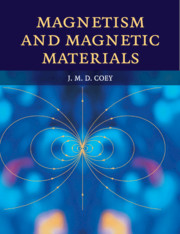Book contents
- Frontmatter
- Contents
- List of tables of numerical data
- Preface
- Acknowledgements
- 1 Introduction
- 2 Magnetostatics
- 3 Magnetism of electrons
- 4 Magnetism of localized electrons on the atom
- 5 Ferromagnetism and exchange
- 6 Antiferromagnetism and other magnetic order
- 7 Micromagnetism, domains and hysteresis
- 8 Nanoscale magnetism
- 9 Magnetic resonance
- 10 Experimental methods
- 11 Magnetic materials
- 12 Applications of soft magnets
- 13 Applications of hard magnets
- 14 Spin electronics and magnetic recording
- 15 Special topics
- Appendices
- Formula index
- Index
- Tables, conversions, constants and units
9 - Magnetic resonance
Published online by Cambridge University Press: 05 June 2012
- Frontmatter
- Contents
- List of tables of numerical data
- Preface
- Acknowledgements
- 1 Introduction
- 2 Magnetostatics
- 3 Magnetism of electrons
- 4 Magnetism of localized electrons on the atom
- 5 Ferromagnetism and exchange
- 6 Antiferromagnetism and other magnetic order
- 7 Micromagnetism, domains and hysteresis
- 8 Nanoscale magnetism
- 9 Magnetic resonance
- 10 Experimental methods
- 11 Magnetic materials
- 12 Applications of soft magnets
- 13 Applications of hard magnets
- 14 Spin electronics and magnetic recording
- 15 Special topics
- Appendices
- Formula index
- Index
- Tables, conversions, constants and units
Summary
Resonance arises when the energy levels of a quantized system of electronic or nuclear moments are Zeeman split by a uniform magnetic field and the system absorbs energy from an oscillating magnetic field at sharply defined frequencies, which correspond to transitions between the levels. Classically, resonance occurs when a transverse AC field is applied at the Larmor frequency. Resonance methods are valuable for investigating the structure and magnetic properties of solids, and they are used for imaging and other applications. The resonant moment may be an isolated ionic spin or free radical, as in electron paramagnetic resonance (EPR), or a nuclear spin as in nuclear magnetic resonance (NMR). Otherwise it can be the ordered magnetization as in ferromagnetic resonance (FMR). Resonant effects are also associated with spin waves, and domain walls. The related techniques of Mössbauer spectroscopy and muon spin resonance provide further information on hyperfine interactions in solids.
A magnetic system placed in a uniform magnetic field B0 may absorb electromagnetic radiation at a precisely defined frequency ν0 = ω0/2π which falls in the radio-frequency or microwave range. The phenomenon is related to the Larmor precession of the magnetic moment, introduced in §3.2.2. In order to observe the resonance, an experimental geometry with crossed magnetic fields is needed. The steady uniform field defines the z-direction, while a high-frequency AC field bx = 2b1 cos ωt is applied in the perpendicular plane.
- Type
- Chapter
- Information
- Magnetism and Magnetic Materials , pp. 305 - 332Publisher: Cambridge University PressPrint publication year: 2010

